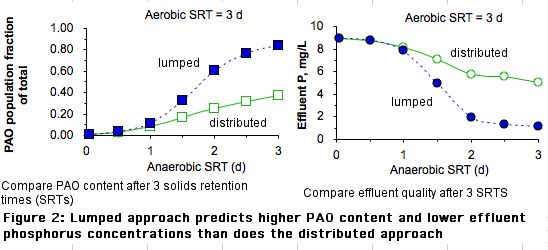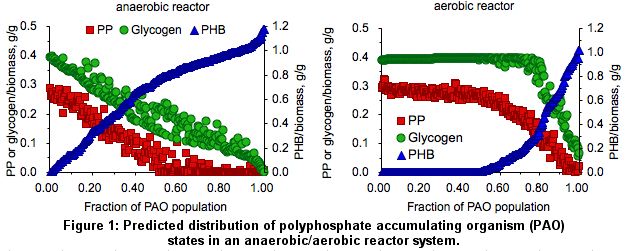Diversity Matters: Agent-Based Mathematical Modeling of Bacterial States in Biological Treatment Systems (The Dissimulator Program)
Common themes in our research are biological diversity and its roles in population dynamics and system performance. We have shown through mathematical modeling that diversity of microbial states is likely to be important to processes that rely on microbial storage product accumulating bacteria, such as enhanced biological phosphorus removal (EBPR) from wastewater. We have developed a new Matlab-based program (DisSimulator) that simulates individual bacteria as they move through a wastewater treatment system - this allows us to track the evolution of bacterial states with time, and to predict the subsequent effects on system performance.
The bacteria responsible for removal of phosphorus from wastewater are unique in that they are thought to accumulate 3 different microbial storage products: polyphosphate, glycogen, and polyhydroxyalkanoates (PHAs). These organisms are commonly referred to as polyphosphate-accumulating organisms (PAOs). The accumulation and degradation of these storage products occurs through cycling of PAOs through anaerobic and aerobic reactors. We have demonstrated that the variability in residence times certain to occur in biological reactors leads to a diversity of states (Figure 1; Schuler, 2005.).
Click here for a Quicktime Movie showing the dynamic evolution of PAO states with time. Continued development of DisSimulator is an active project in our laboratory - interested collaborators and potential graduate students should contact Dr. Schuler.
Most importantly, we have demonstrated that ignoring the existence of distrubted states, as is commonly done in "lumped model" approaches, may lead to overestimates of process performance, and this in turn can lead to undersized wastewater systems and consequent increased risks to downstream ecosystems and human health. For example, Figure 2 shows a comparision of predicted PAO content and effluent phosophorus concentrations over a range of design conditions for simple phosphorus removing system. For more information see our recent articles (1) (2) (3).

